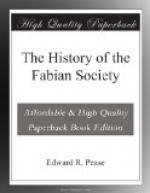In 1912 Barrow House, Derwentwater, was taken for three years, a beautiful place with the Barrow Falls in the garden on one side, and grounds sloping down to the lake on the other, with its own boating pier and bathing-place. A camp of tents for men was set up, and as many as fifty or sixty guests could be accommodated at a time. Much of the success of the School has throughout been due to Miss Mary Hankinson, who from nearly the beginning has been a most popular and efficient manager. A director is selected by the Committee to act as nominal head, and holds office usually for a week or a fortnight; but the chief of staff is a permanent institution, and is not only business manager, but also organiser and leader of excursions and a principal figure in all social undertakings. A great part in arranging for the School from the first has been taken by Dr. Lawson Dodd, to whose experience and energy much of its success has been due.
* * * * *
The year 1911 saw the formation of the Joint Standing Committee with the I.L.P., and this is a convenient place to describe the series of attempts at Socialist Unity which began a long way back in the history of the Society. For the first eight years or so of the Socialist movement the problem of unity did not arise. Until the publication of “Fabian Essays” the Fabian Society was small, and the S.D.F., firm in its Marxian faith, and confident that the only way of salvation was its particular way, had no more idea of uniting with the other societies than the Roman Catholic Church has of union with Lutherans or Methodists. The Socialist League was the outcome of an internal dispute, and, if my memory is correct, the S.D.F. expected, not without reason, that the seceders would ultimately return to the fold. The League ceased to count when at the end of 1890 William Morris left it and reconstituted as the Hammersmith Socialist Society the branch which met in the little hall constructed out of the stable attached to Kelmscott House.
In January, 1893, seven delegates from this Society held a conference with Fabian delegates, and at a second meeting at which S.D.F. delegates were present a scheme for promoting unity was approved. A Joint Committee of five from each body assembled on February 23rd, when William Morris was appointed Chairman, with Sydney Olivier as Treasurer, and it was decided that the Chairman with H.M. Hyndman and Bernard Shaw should draft a Joint Manifesto. The “Manifesto of English Socialists,” published on May 1st, 1893, as a penny pamphlet with the customary red cover, was signed by the three Secretaries, H.W. Lee of the S.D.F., Emery Walker of the H.S.S., and myself, and by fifteen delegates, including Sydney Olivier and Sidney Webb of the F.S., Harry Quelch of the S.D.F., and the three authors.




